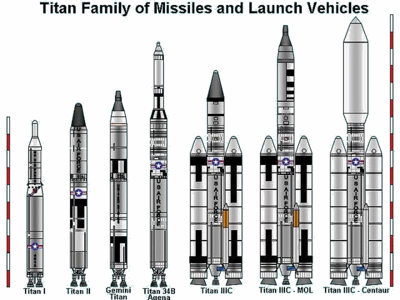Titan (rocket family)
|
|
| Titan family | ||||||||||||||||||||||||||||||||||||||||||||||||
|---|---|---|---|---|---|---|---|---|---|---|---|---|---|---|---|---|---|---|---|---|---|---|---|---|---|---|---|---|---|---|---|---|---|---|---|---|---|---|---|---|---|---|---|---|---|---|---|---|
| Missing image Titan2.jpg Titan II Gemini launch Titan II launching a Gemini spacecraft. | ||||||||||||||||||||||||||||||||||||||||||||||||
| Template:Commons | ||||||||||||||||||||||||||||||||||||||||||||||||
| ||||||||||||||||||||||||||||||||||||||||||||||||
| ||||||||||||||||||||||||||||||||||||||||||||||||
| ||||||||||||||||||||||||||||||||||||||||||||||||
| ||||||||||||||||||||||||||||||||||||||||||||||||
| ||||||||||||||||||||||||||||||||||||||||||||||||
Titan is a family of U.S. expendable rockets.
Titans launched today use a Centaur upper stage.
Most Titan rockets are derivatives of the Titan II ICBM. The Titan II is a hypergolicly-fueled two-stage ICBM that was used by the U.S. Air Force from the mid 1960s to the mid 1980s. In the late 80s some of the deactivated Titan IIs were converted into space launch vehicles to be used launching U.S. Government payloads. The final such vehicle launched a DMSP weather satellite from Vandenberg AFB in 2003 [1] (http://spaceflightnow.com/titan/g9/031018launch.html). Titan IIs were also used to launch the U.S. manned Gemini capsules.
The Titan 23B and its derivatives (24B, 33B, and 34B) are Titan IIs with an Agena D upper stage. This combination was use to launch the KH-8 GAMBIT series of spy satellites. They were all launched from Vandenberg AFB, CA, into polar orbits. The payload was about 7,500 lb (3,000 kg).
The Titan III is a stretched Titan II with optional solid rocket boosters. It was developed by the U.S. Air Force as a heavy-lift satellite launcher to be used mainly to launch U.S. Military payloads such as DSP early-warning, intelligence (spy), and defense communications satellites. It was also used to launch some NASA scientific probes such as the Voyagers.
The Titan IV is a stretched Titan III with non-optional solid rocket boosters. It is almost exclusively used to launch U.S. Military payloads, though it was also used to launch NASA's Cassini probe to Saturn after the Shuttle-Centaur program was canceled following the loss of Challenger. Titan IV is the largest launch vehicle flying as of 2004. It is extremely expensive to operate.
The Titan I was the first version of the Titan family of rockets. It began as a backup ICBM project in case the Atlas was delayed. It is a two-stage rocket powered by RP-1 and LOX. The Titan I and Atlas ICBM's using RP-1/LOX fuel do not have a fast reaction time. They took about 1/2 hour to fuel and launch.
The Liquid Oxygen is very dangerous to use in an enclosed space, such as a missile silo. Several Atlas and Titan I rockets exploded and destroyed their silos. The Martin Company was able to improve the Titan design in the Titan II. The LOX/RP-1 was replaced by storable fuel in the Titan II. The same first stage rocket engines were used with some modifications. The diameter of the second stage was increased to match the first stage. The Titan II storable fuel and oxydizer are hypergolic, they ignite on contact when mixed. This also was dangerous to handle in an enclosed space. There were several accidents in Titan II silos resulting in loss of life. In August 1965, 53 construction workers were killed when hydraulic fluid used in the Titan II, caught fire in a missile silo in Arkansas. In the 1980s, in another Arkansas Titan II silo, leaking rocket fuel ignited and blew the 6,000 lb nuclear warhead out of the silo and several hundred feet away. This marked the beginning of the end for the Titan II as an ICBM. The 54 Titan II's were replaced in the U.S. arsenal by 50 MX Peacekeeper solid fuel missiles in late 1980s. Approximately 50 Titan IIs were fielded along with some 1000 Minutemen from the mid-1960s through the mid-1980s.
As of 2004, the end of the Titan family of rockets was in sight. Three Titan IVBs remained to be launched and no more were ordered. The current owners of the Titan line (Lockheed-Martin) have decided to extend their Atlas family of rockets instead of the Titans. By 2005 the Titans will likely be extinct.
The second-to-last Titan launched successfully from Cape Canaveral on April 29, 2005. The final Titan is scheduled to launch from Vandenberg in July.
All of the Titan ICBM sites have been destroyed except one that is now the Titan Missile Museum near Tucson, Arizona.
- Titan I - Lox/RP-1 fueled ICBM.
- Titan II- Storable fuel ICBM and Gemini Launch Vehicle.
- Titan 23B- Titan II/Agena launched KH-8 spy satellites.
- Titan III- Launched heavy payloads, planned Dyna-Soar MOL launcher.
- Titan IV- Launcher for heavy "Shuttle" class payloads.
External links
- Titan I ICBM History site (http://www.geocities.com/titan_1_missile/)
- Titan II ICBM History site (http://www.geocities.com/titan_2_missile/)
- Titan Missile Museum (http://www.pimaair.org/TitanMM/titanhome.shtml)de:Titan (Rakete)
fi:Titan IV fr:Titan (fusée) it:Titan nl:Titan (raket) pl:Titan (rakieta)

